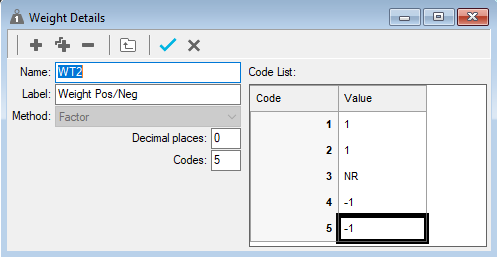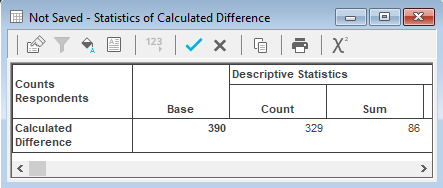Using weights to calculate the difference in rating
Sometimes Weights are used as part of a calculation. They give different scores to the responses, so you can convert a variable code into another value for calculation.
You can use weights to subtract the negative from the positive values of a rating scale variable. By using this data in a statistics table, you can see whether the ratings were generally positive or negative.
This example assumes a five-code scale, in which the middle value is neutral, such as Q6a (speed of service). Because the rating scale only contains counts of responses, you need to set up a derived variable in order to calculate the statistics of the scored response.
- Click
 to display the Weights window.
to display the Weights window. - Click
 to add a new weight and specify the Weight Details as follows:
to add a new weight and specify the Weight Details as follows: - Name: WT6
- Label: Weight pos/neg
- Decimal places: 0
- Number of codes: 5
- Specify the Code Details:

- Click
 to save the Weight.
to save the Weight. - Click
 to display the Variables window.
to display the Variables window. - Click
 to add a new variable.
to add a new variable. - Specify the Variable Details:
- Name: V10
- Label: Calculated difference
- Type: Derived (the variable will derive its data from other existing variables).
- Response: Quantity (the response will be a numeric value for each case).
- Specify the Code Details to combine the Weight with the Speed of service rating variable:
Code | Code Label | Value |
OK | Valid | WT6(Q6.a) |
-
Click on
 to save the variable.
to save the variable.
-
Click
 to display the Analysis Definition dialog to create a table.
to display the Analysis Definition dialog to create a table.
- Specify the Analysis as V10, which is the variable to be weighted.
- Select Statistics table from the list for the Break (or enter STATS).
- Click OK and the table will be built.
The Sum will be the difference between the positive and negative values.
